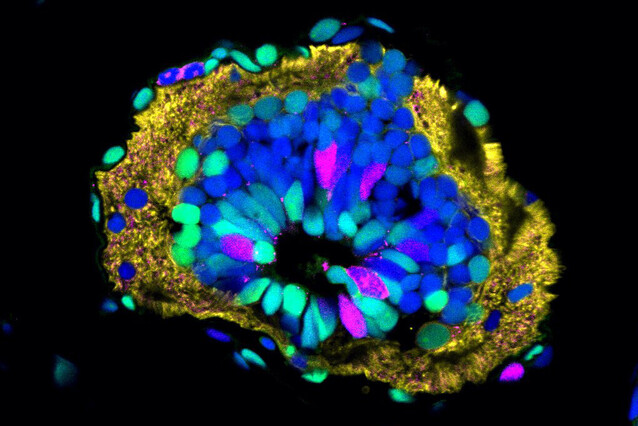Ready, set, go – or how stem cells synchronise to repair the spinal cord in axolotls

Few animals can regenerate their spinal cord after an injury. The axolotl, a salamander endemic to Mexico, can mobilise stem cells in its spinal cord to regrow the lost tissue. An international team of scientists investigated the early stages of this process and found that stem cells synchronise over surprisingly long distances to orchestrate regeneration. Their findings are now published on the online platform eLife.
The spinal cord is an important component of our central nervous system: it connects the brain with the rest of the body and plays a crucial part in coordinating our sensations with our actions. Falls, violence, disease – various forms of trauma can cause irreversible damage to the spinal cord, leading to paralysis, sometimes even death.
Although many vertebrates, including humans, are unable to recover from a spinal cord injury, some animals stand out. For instance, the axolotl (Ambystoma mexicanum), a salamander from Mexico, has the remarkable ability to regenerate its spinal cord after an injury. When an axolotl’s tail is amputated, neural stem cells residing in the spinal cord are recruited to the injury to rebuild the tail. So far, scientists could only detect this activity a few days after the process had started.
“Four days after amputation, stem cells within about one millimetre of the injury divide three times as fast as the normal rate to regenerate the spinal cord and replace lost neurons,” explains Emanuel Cura Costa, co-first author of the study. “What the stem cells are doing in the first four days after injury was the real mystery.”
To understand what happens in the first moments of spinal cord regeneration, researchers at Argentina’s National Scientific and Technical Research Council (CONICET) and at the IMP teamed up to recreate the process in a mathematical model and test its predictions in axolotl tissue with the latest imaging technologies. Their findings, published in eLife, show that neural stem cells accelerate their cell cycles in a highly synchronised manner, with the activation spreading along the spinal cord.
Regenerating in sync: cells follow the tempo
In the uninjured spinal cord, cells multiply asynchronously: some are actively replicating their DNA before splitting into two cells to sustain growth, while some are simply resting.
The scientists’ model predicted that this could change dramatically upon injury: most cells in the vicinity of the injury would jump to a specific stage of the cell cycle to synchronise and proliferate in unison.
Simulation of the modelled axolotl spinal cord showing the injury (black dashed vertical line) and the progression of a signal (red dashed vertical line) while recruiting stem cells. Activated cells are in magenta, while resting cells are in green. The outgrowth of the tissue is depicted in the blue dashed vertical line.
“We developed a tool to track individual cells in the growing spinal cord of axolotls. Different colours label resting and active cells, which allow us to see how far and how fast cell proliferation happens with a microscope,” says Leo Otsuki, postdoc in the lab of Elly Tanaka at the IMP and co-first author of this study. “We were very excited to see the match between the theoretical predictions and the experimental results.”
The way cells multiply in chorus in the regenerating spinal cord is exceptional in animals. How can cells coordinate their efforts over almost one millimetre - 50 times the size of a single cell?
3D reconstruction of axolotl tail tissue. The spinal cord is the tube-shaped structure in the middle. Proliferating cells are magenta, resting cells are green and cell nuclei are stained in blue.
A mystery signal orchestrating regeneration
“Our model made us realise there had to be one or more signals that spread through the tissue from the injury, like a wave, for the area of proliferating cells to expand,” explains Osvaldo Chara, career researcher at CONICET and group leader of SysBio at the Institute of Physics of Liquids and Biological Systems (IFLySIB). “This signal might act like a messenger and instruct stem cells to proliferate.”
The researchers suspect that this mystery messenger helps reprogram stem cells to divide rapidly and regrow amputated tissue. Their work pinpoints this signal in space and time, and paves the way to characterise it further.
“Combining mathematical models with our expertise in tissue imaging was key to understanding how the spinal cord starts regenerating,” says Elly Tanaka, senior scientist at the IMP. “The next step is to identify the molecules that promote regeneration of the spinal cord - that could have tremendous therapeutic potential for patients with spinal injuries.”
Original publication
Cura Costa, E., Otsuki, L., Rodrigo Albors, A., Tanaka, E. M., Chara, O.: “Spatiotemporal control of cell cycle acceleration during axolotl spinal cord regeneration”. eLife, 15 June 2021. DOI: : https://doi.org/10.7554/eLife.55665.





